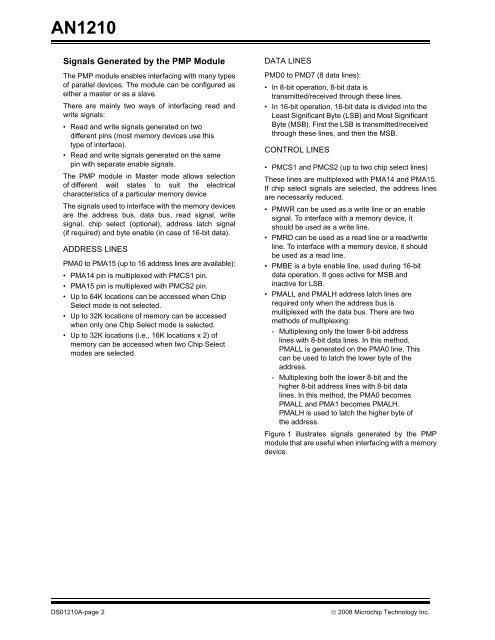Using External Memory with PIC24F/24H/dsPIC33F ... - Microchip
Using External Memory with PIC24F/24H/dsPIC33F ... - Microchip
Using External Memory with PIC24F/24H/dsPIC33F ... - Microchip
You also want an ePaper? Increase the reach of your titles
YUMPU automatically turns print PDFs into web optimized ePapers that Google loves.
AN1210<br />
Signals Generated by the PMP Module<br />
The PMP module enables interfacing <strong>with</strong> many types<br />
of parallel devices. The module can be configured as<br />
either a master or as a slave.<br />
There are mainly two ways of interfacing read and<br />
write signals:<br />
• Read and write signals generated on two<br />
different pins (most memory devices use this<br />
type of interface).<br />
• Read and write signals generated on the same<br />
pin <strong>with</strong> separate enable signals.<br />
The PMP module in Master mode allows selection<br />
of different wait states to suit the electrical<br />
characteristics of a particular memory device<br />
The signals used to interface <strong>with</strong> the memory devices<br />
are the address bus, data bus, read signal, write<br />
signal, chip select (optional), address latch signal<br />
(if required) and byte enable (in case of 16-bit data).<br />
ADDRESS LINES<br />
PMA0 to PMA15 (up to 16 address lines are available):<br />
• PMA14 pin is multiplexed <strong>with</strong> PMCS1 pin.<br />
• PMA15 pin is multiplexed <strong>with</strong> PMCS2 pin.<br />
• Up to 64K locations can be accessed when Chip<br />
Select mode is not selected.<br />
• Up to 32K locations of memory can be accessed<br />
when only one Chip Select mode is selected.<br />
• Up to 32K locations (i.e., 16K locations x 2) of<br />
memory can be accessed when two Chip Select<br />
modes are selected.<br />
DATA LINES<br />
PMD0 to PMD7 (8 data lines):<br />
• In 8-bit operation, 8-bit data is<br />
transmitted/received through these lines.<br />
• In 16-bit operation, 16-bit data is divided into the<br />
Least Significant Byte (LSB) and Most Significant<br />
Byte (MSB). First the LSB is transmitted/received<br />
through these lines, and then the MSB.<br />
CONTROL LINES<br />
• PMCS1 and PMCS2 (up to two chip select lines)<br />
These lines are multiplexed <strong>with</strong> PMA14 and PMA15.<br />
If chip select signals are selected, the address lines<br />
are necessarily reduced.<br />
• PMWR can be used as a write line or an enable<br />
signal. To interface <strong>with</strong> a memory device, it<br />
should be used as a write line.<br />
• PMRD can be used as a read line or a read/write<br />
line. To interface <strong>with</strong> a memory device, it should<br />
be used as a read line.<br />
• PMBE is a byte enable line, used during 16-bit<br />
data operation. It goes active for MSB and<br />
inactive for LSB.<br />
• PMALL and PMALH address latch lines are<br />
required only when the address bus is<br />
multiplexed <strong>with</strong> the data bus. There are two<br />
methods of multiplexing:<br />
- Multiplexing only the lower 8-bit address<br />
lines <strong>with</strong> 8-bit data lines. In this method,<br />
PMALL is generated on the PMA0 line. This<br />
can be used to latch the lower byte of the<br />
address.<br />
- Multiplexing both the lower 8-bit and the<br />
higher 8-bit address lines <strong>with</strong> 8-bit data<br />
lines. In this method, the PMA0 becomes<br />
PMALL and PMA1 becomes PMALH.<br />
PMALH is used to latch the higher byte of<br />
the address.<br />
Figure 1 illustrates signals generated by the PMP<br />
module that are useful when interfacing <strong>with</strong> a memory<br />
device.<br />
DS01210A-page 2 © 2008 <strong>Microchip</strong> Technology Inc.
















